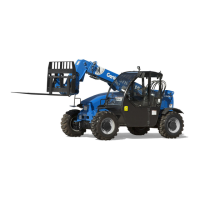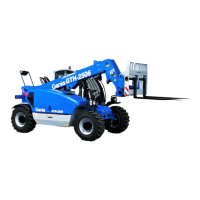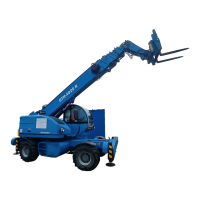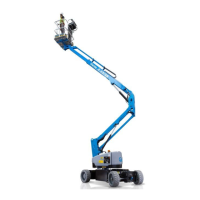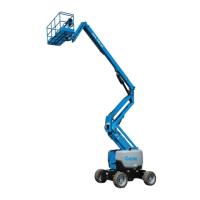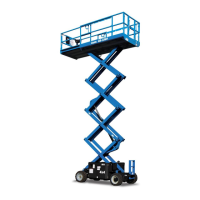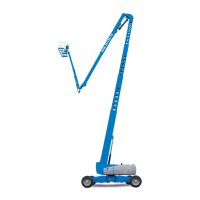Do you have a question about the Terex Genie GTH-1056 and is the answer not in the manual?
Overview of the manual's content and purpose.
Locates serial number and identification labels on the machine.
Defines the machine's purpose as a rough terrain forklift.
Explains safety bulletins and compliance requirements.
Provides information needed when contacting Genie for support.
Details the process for updating owner information.
Lists essential conditions and training required before operating.
Explains safety decals, symbols, and signal words.
Lists relevant industry standards for forklift operation.
Provides guidelines for maintaining safety signs.
Warns about the dangers of electrical contact.
Details risks from moving parts, loads, and rollover.
Emphasizes precautions against falling.
Highlights risks from high-pressure fluid leaks.
Warns about contact with hot surfaces.
Covers risks from fuel, fumes, and batteries.
Addresses risks associated with machine tip-over.
Explains safety regarding access to machine compartments.
Focuses on avoiding collisions with people and equipment.
Details risks from falling objects and precautions.
Explains factors leading to machine tip-over.
Provides guidance for safe operation on inclines.
Safety measures for preventing falls.
Avoiding collisions during operation.
Precautions against falling objects.
Risks of injury during operation and maintenance.
Dangers of operating a faulty machine.
Avoiding damage to machine components.
Risks from moving parts and stabilizers.
Dangers related to flammable substances.
Risks of electrical contact and clearance requirements.
Safe practices for battery handling and charging.
Outlines employer duties for a safe workplace.
Describes the layout and function of the main control panel.
Operation of the steering wheel for directional control.
Function of the switch for selecting steering modes.
Operation of the parking brake.
Procedure for starting and stopping the engine.
Operation of the primary control lever for boom and fork movements.
Operation of auxiliary hydraulic functions.
Function of the accelerator pedal for speed control.
Function of the brake pedal for stopping and slowing.
Engaging the differential lock for improved traction.
Controlling machine direction and speed.
Explains the gauges, indicators, and displays on the instrument panel.
Importance and purpose of pre-operation checks.
Essential conditions and training required before operating.
Checklist for pre-operation machine inspection.
Specific items and conditions to verify during inspection.
Purpose and procedure for testing machine functions.
Essential conditions and training required before operating.
Step-by-step guide for testing all machine functions.
Procedures for testing single control handle functions.
Procedures for testing dual control handle functions.
Verifying the proper operation of the steering system.
Procedures for testing transmission and brake systems.
Verifying the operation of the stabilizer system.
Testing the functionality of auxiliary hydraulics.
Checking drive and sway functions under specific conditions.
Verifying the functionality of all machine lights.
Testing the shifting mechanism of the 2-speed transmission.
Importance of inspecting the work area prior to operation.
List of hazards to check in the operating environment.
Verifying the legibility and placement of decals.
Verifying the legibility and placement of decals.
Overview of operating instructions and safety rules.
Essential conditions and training required before operating.
Procedures for applying and releasing the parking brake.
How to use the brake pedal for speed control and stopping.
Step-by-step guide for starting the engine.
How to choose and switch between steering modes.
Procedures for deploying and retracting stabilizers.
Instructions for using the emergency exit window.
How to control machine direction and speed using the lever.
How to engage the axle differential lock for enhanced traction.
Using the sway control to level the machine frame.
Safe methods for transporting loads on the machine.
Procedures for lifting and setting down loads safely.
Safety precautions and best practices for operating on inclines.
Diagrams illustrating single control handle operations.
Diagrams illustrating dual control handle operations.
How the rear axle lock affects operation and sway function.
Procedures for attaching and removing quick attach components.
Interpreting engine diagnostic indicators for faults.
Safe procedures for jump starting the engine.
General safety rules and responsibilities for transport.
Methods for securing the machine for transport.
Using chains and tie-down points for chassis securement.
Rules for operator vs. technician maintenance tasks.
Explains symbols used in maintenance procedures.
Procedure for checking and adding engine oil.
Recommended diesel fuel types for different engines.
Procedure for checking and adding hydraulic oil.
Procedures for checking battery condition and connections.
Procedure for checking engine coolant levels.
Procedure for checking and adjusting tire pressure.
Requirements for periodic maintenance performed by technicians.
Safety considerations when using work platforms.
Safety rules for operating with work platforms.
Requirements for personnel within the work platform.
Requirements for personal fall protection equipment.
Rules for entering, exiting, and staying in the platform.
Safe operation of the telehandler when using platforms.
Procedures for safely lifting personnel with attachments.
Preparation and setup guidelines for platform use.
Steps for correctly attaching and securing the work platform.
Guidelines for safe platform entry and exit.
Procedures for safely lifting and lowering the platform.
General safety precautions for lifting suspended loads.
Safety considerations for the work area during suspended load operations.
Factors that can cause overturning when handling suspended loads.
Avoiding collisions when lifting or moving loads.
Hazards involving signal persons and suspended loads.
Risks and precautions related to falling objects.
Procedures for safely lifting suspended loads.
Safe travel practices when carrying suspended loads.
Procedures for safely positioning suspended loads.
Requirements and responsibilities of a signal person.
| Brand | Terex |
|---|---|
| Model | Genie GTH-1056 |
| Category | Boom Lifts |
| Language | English |
